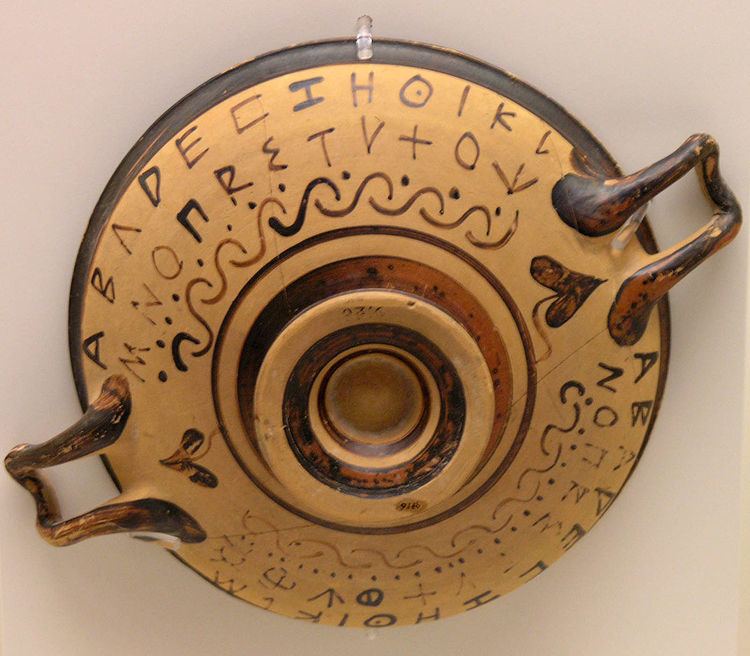 | ||
Beta ( /ˈbiːtə/ or /ˈbeɪtə/; uppercase Β, lowercase β, or cursive ϐ; Ancient Greek: βῆτα bḗta or Modern Greek: βήτα víta) is the second letter of the Greek alphabet. In the system of Greek numerals it has a value of 2. In Ancient Greek, beta represented the voiced bilabial plosive /b/. In Modern Greek, it represents the voiced labiodental fricative /v/. Letters that arose from beta include the Roman letter ⟨B⟩ and the Cyrillic letters ⟨Б⟩ and ⟨В⟩.
Contents
Name
Like the names of most other Greek letters, the name of beta was adopted from the acrophonic name of the corresponding letter in Phoenician, which was the common Semitic word *bayt ('house'). In Greek, the name was βῆτα bêta, pronounced [bɛ̂ːta] in Ancient Greek. It is spelled βήτα in modern monotonic orthography, and pronounced [ˈvita]. In US English, the name is pronounced /ˈbeɪtə/, while in British English it is pronounced /ˈbiːtə/.
History
The letter beta was derived from the Phoenician letter beth .
The letter Β had the largest number of highly divergent local forms. Besides the standard form (either rounded or pointed, ), there were forms as varied as (Gortyn), and (Thera), (Argos), (Melos), (Corinth), (Megara, Byzantium), (Cyclades).
Algebraic numerals
In the system of Greek numerals, beta has a value of 2. Such use is denoted by a number mark: Β′.
Computing
In computing, the term "beta" is used as (usually) the last testing release (or the preview release) in the software release life cycle before the "release" version. Beta versions often have a version number of the form "0.n", (or "build number"). Typically it is the last version before a version of a software is fully released to all its actual customers.
Finance
Beta is used in finance as a measure of investment portfolio risk. Beta in this context is calculated as the covariance of the portfolio's returns with its benchmark's returns, divided by the variance of the benchmark's returns. A beta of 1.5 means that for every 1% change in the value of the benchmark, the portfolio's value changes by 1.5%.
International Phonetic Alphabet
In the International Phonetic Alphabet, Greek minuscule beta denotes a voiced bilabial fricative [β].
Meteorology
The name Beta was used as a name during the 2005 Atlantic hurricane season as Hurricane Beta.
Mathematics and science
Beta is often used to denote a variable in mathematics and physics, where it often has specific meanings for certain applications. In physics a stream of unbound energetic electrons is commonly referred to as beta radiation or beta rays. In regression analysis, ⟨B⟩ symbolizes nonstandardized partial slope coefficients, whereas ⟨β⟩ represents standardized (standard deviation-score form) coefficients; in both cases, the coefficients reflect the change in the criterion Y per one-unit change in the value of the associated predictor X.
β is sometimes used as a placeholder for an ordinal number if α is already used.
In spaceflight, beta angle describes the angle between the orbit plane of a spacecraft or other body and the vector from the sun.
Rock climbing terminology
The term "beta" refers to advice on how to successfully complete a particular climbing route, boulder problem, or crux sequence.
Statistics
In statistics, beta may represent type II error, or regression slope.
Typography
In some high-quality typesetting, especially in the French tradition, a typographic variant of the lowercase letter without a descender is used within a word for ancient Greek: βίβλος is printed βίϐλος.
In typesetting technical literature, it is a commonly made mistake to use the German letter ß (a s–z or s–s ligature) as a replacement for β. The two letters resemble each other in some fonts, but they are unrelated.
Videotape formats
"Beta" can be used to refer to several consumer and professional videotape formats developed by Japan's Sony Corporation. Although similarly named, they are very different in function and obsolescence.
Character encodings
These characters are used only as mathematical symbols. Stylized Greek text should be encoded using the normal Greek letters, with markup and formatting to indicate text style.
